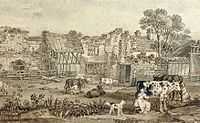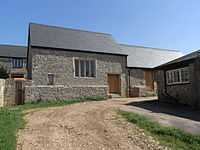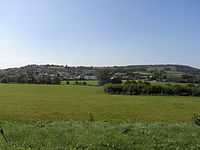Colcombe Castle




Colcombe Castle was a now lost castle or fortified house situated about 1/2 mile north of the village of Colyton in East Devon.
It was a seat of the Courtenay family, Earls of Devon, whose principal seat was Tiverton Castle, about 22 miles to the NW. It was used as his seat by Thomas de Courtenay, 5th Earl of Devon (d.1458) whilst his widowed mother occupied Tiverton Castle as her dower house. Its position near to Shute, the seat of William Bonville, 1st Baron Bonville (1392–1461), the arch-enemy of the 5th Earl, led to some serious territorial battles between the two families, culminating in the Battle of Clyst Heath of 1455.
History

Tristram Risdon writing c.1630 described the descent of the manor of Colyford thus:
The manor at the Conquest was parcel of the king's demesne, which the Conqueror gave to Robert de Mount Chardon; but being released again was by King Henry II, with the manor of Whitford, bestowed on Sir Alan Dunstanville, whose son Sir Walter Dunstanville gave it in marriage unto Sir Thomas Bassett, his nephew, younger son of the Lord Bassett, by Alice, sister of the said Walter; which gift was by consent of King John. This land descended unto the two daughters of the said Sir Thomas Bassett: Joan, first married unto Sir Reginald Valletort, second unto Sir William Courtenay, younger son of the Lord Courtenay. Alice, the other daughter, was married unto Sir Thomas Sanford, and secondly unto Sir John Bissett, whose part afterwards was sold unto Hugh Courtenay, Earl of Devon, so that the whole manors of Colliton and Whitford came to be the possessions of the Earls of Devon, who builded a mansion house at Colcombe, near Colliton, which was intended to be stately built but his death, and the attainder of Henry his son, left the same to the ruins of time. This land was restored unto Edward Courtenay, the last earl of this family, by Queen Mary, and by death, left to descend to the heirs general who sold this manor and house. Now the manor are divided; the one moiety the lord Petre possesseth, the other moiety Sir John Pole and Sir John Drake, knights, enjoy
Hoskins states that it was first built during the reign of King Edward I (1272-1307) by Hugh de Courtenay, 1st Earl of Devon (1276–1340) [1] and was rebuilt ("on a magnificent scale", according to Hoskins [2]) by Henry Courtenay, 1st Marquess of Exeter, 2nd Earl of Devon (1498–1539), after whose attainder and execution it became forfeit to the crown. It was restored with other lands to his son Edward Courtenay, 1st Earl of Devon (1527–1556), after whose death it passed, together with Tiverton Castle, to his heirs, the descendants of his four great-aunts, and fell into a ruinous state.
Part of the Colcombe estate was purchased by William Pole Esquire (d.1588), who had purchased Shute House in 1560. His son Sir William Pole (1561-1635), the antiquary, purchased the remaining shares from the heirs of the Courtenays, and rebuilt the house, as he recorded after 1618 in his "Collections towards a History of Devon":A goodly building was here intended by the last erles but altogether unfinished, and nowe the whole being reduced from all ye co-heires unto my possession, I have newe built the howse and made it the place of my residinge".[3]Sir William resided most of his younger life at Shute, until 1618, during which time he let his son John, later the 1st Pole baronet, live in the former building at Colcombe, as is evidenced by the record of the birth of John's second son Courtenay Pole, which described his father as "John Pole of Colcombe".[4] In 1618 Sir William Pole exchanged residences with his son John, to whom he let Shute, and himself moved to Colcombe, which he then set about rebuilding and where he died in 1635.[5] During the Civil War it served in 1644 as the headquarters of Prince Maurice (d.1652), who used it as a base for his attack on Stedcombe, then being used as a garrison for parliamentary troops by its owner Sir Walter Erle. It was almost completely destroyed, with only part of the kitchen and a large fireplace having survived.[4] During the conflagration, many of the volumes of the manuscripts of the antiquary's great work on the history of Devon, with substantial additions made by his son the 1st baronet, were destroyed. [6] After the Civil War part was rebuilt on the other side of a lane as a farmhouse.[7] Colcombe appears to have passed out of the Pole family after the time of the 1st baronet, but was repurchased by Sir John de la Pole, 6th Baronet (1757-1799), the builder of New Shute House, possibly from Sir George Yonge of Colyton, from whom he had acquired several large properties in 1790.[8] The 6th baronet seems to have decided to re-build it in the grand style of its former existence when owned by Henry Courtenay, 1st Marquess of Exeter, 2nd Earl of Devon (1498–1539). However he died before his plan could be effected and stipulated in his will that his heirs should build "a good substantial dwelling-house with suitable offices and at least five acres of land in Colcombe Park where his widow should live". It is unlikely the request was ever acted upon. His widow is known to have spent her last days at Lindridge House near Plymouth tending her sick brother.[9]
Description

Having dined here (i.e. Colyton) about five I quitted it for Colcombe Castle, which lay about half a mile from the town. Having by a bridge crost the River Coly, I turned to the left and quickly came to the ruins of this once capital mansion. Perhaps little if any of the edifice wherein once the Courtenay Earls of Devon resided is now to be seen...Of this house of Colcombe, which Sir William (Pole) called a Castle are the present ruins. The whole of the are seen in the preceding sketch (i.e. dated 26/1/1795) and consisting of the interior part of the building are nearly the same as the print given in the "History of Devon" (i.e.by Polwhele). What was once the Forum at Rome is now become a cow-market, and the castle of the Earls of Devon and of the antiquary Sir Wm Pole is now converted into a farmer's dung-court, such is the transition from splendour to meaness. And from the pride and honour of strength to the lowest degradation and decay! On the western side, separated by a lane, is the house in which the farmer dwells who rents the estate of Colcombe of Sir J. de la Pole and which was probably built from the ruins of the castle. Standing by the door of it I took the preceding sketch (i.e. dated 27/1/1795) which will give some notion of the front and which seems to have been the principal one with an aspect to the west commanding the beuatiful scenery of the expanse of pasture beneath through which ran the River Coly, of the hilly woodlands in Shute Park to the right and the beautifull object of Colyton to the left the situation had been happily chosen. It had in view many picturesqu beauties and placed sub aprico colle (i.e. "under a sunny hill") was well calculated for a family residence".
Sources
- Listed Buildings text, Colcombe Castle
- Pevsner, N., & Cherry, B., Buildings of England: Devon, London, 2004, pp.273-4
- Hoskins, W.G., A New Survey of England: Devon, London, 1959, p.374
- Bridie, Marion F., The Story of Shute, Axminster, 1955
External links
References
- ↑ Hoskins, p.374; Listed Buildings text
- ↑ Hoskins, p.374
- ↑ Quoted by Bridie, p.92
- ↑ 4.0 4.1 Bridie, p.92
- ↑ Bridie, p.95
- ↑ Bridie, p.86
- ↑ Listed Buildings text
- ↑ Bridie, p.154
- ↑ According to inscription on her mural monument in Shute Church
- ↑ Pevsner, N., & Cherry, B., Buildings of England: Devon, London, 2004, pp.273-4
- ↑ Gray, Todd (Ed.), Travels in Georgian Devon: The Illustrated Journals of the Reverend John Swete, 1789-1800, 4 Vols., Vol.2, 1998, Tiverton, p.110-111
Coordinates: 50°44′52″N 3°04′00″W / 50.7477°N 3.0666°W